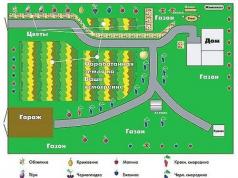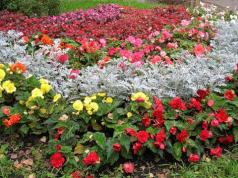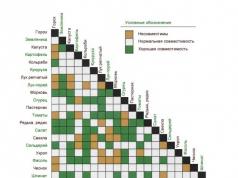Ezhemalina is a hybrid of raspberries and blackberries. It is often called the word "tiberi", but this is not entirely true. Taybury is the most popular variety of Jemalina.
This is a relatively new berry culture for Russia, although in fact the first hybrids of blackberries and raspberries appeared in the United States in the 19th century, and in Russia in the 1930s. They were bred to increase drought resistance, winter hardiness and productivity of raspberries, while maintaining its great taste. Such productive, unpretentious and tasty hybrids did not appear immediately: breeders of the past often failed. However, one hundred and thirty years is a long time: today there are excellent varieties of Yezhemalina, the seedlings of which can be bought in Russia.
Ezhemalina varieties
Taybery
This is the most popular variety. Obtained by crossing the Morus nigra blackberry and Rubus idaeus common raspberry. The variety is patented by Derek L. Jennings Dundee and released by the Scottish Horticultural Research Institute. Named after the River Tai, which flows in Scotland.
Description and reviews
A vigorous shrub with long, creeping stems. The berries are large, dark red with a violet tinge, elongated, up to 4 cm long. The taste is excellent, the aroma is strong, tart. The berries are difficult to separate: this cannot be done with a machine, and therefore Tiberi's raspberry is not used in large agricultural enterprises.
Taybury seedlings are easy to buy in Russia and Ukraine, and the prices are quite affordable. Before transplanting, it is recommended to keep the seedlings at a temperature of 0 to 2 degrees.
Loganberry
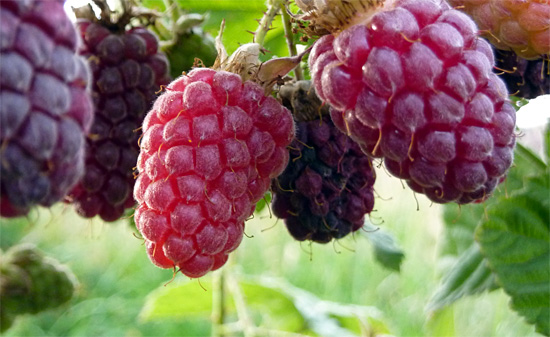
The Loganberry variety is an octaploid hybrid of a tetraploid raspberry and a hexaploid blackberry.
Some explanations should be given here.
Almost all plants have a diploid set of chromosomes - that is, each chromosome has the same pair. During meiosis, the diploid set is divided between two haploid cells. So, sperm in the pollen of plants and eggs in the pistil have a single set of chromosomes. During fertilization, the sperm and the egg merge, and a diploid seed is formed from the resulting diploid cell.
Breeders sometimes use special technologies to duplicate the set of chromosomes - for example, they treat samples with colchicine. This is usually done to overcome the sterility of hybrids: if a hybrid has sets of different in the number and shape of chromosomes, it (the hybrid) cannot reproduce sexually, because normal gametes are not formed in it. If you double the whole set and get a tetraploid organism, the problem will be solved. In addition, polyploid plants usually have larger cells, and they themselves are more productive.
So, a tetraploid raspberry has 4 sets of chromosomes, and a hexaploid blackberry - 6. Somehow they got octaploid (8 sets) ezemalina from them, the variety of which is called Loganberry.
This variety was accidentally obtained in 1881 by American lawyers and breeder James Harvey Logan. Therefore, it was named Loganberry or Loganberry. He wanted to obtain a variety of blackberries suitable for commercial cultivation and crossed different varieties and varieties available at that time. Not far from the plot with blackberries, raspberries grew: there was a cross-pollination, and as a result, ezemalina was obtained.
Ezhemalina Loganberry turned out to be very fruitful and unpretentious, but the taste of the berries was not the best. However, over time, other breeders have improved the variety, and today's Loganberry is not quite similar to the one grown in the late 19th century.
Description and reviews
Stems are high, up to 2 meters, bending under the weight of leaves and inflorescences with berries. Requires a garter. The leaves are dark green, with thorns on the stems and leaf petioles. Inflorescences are large, up to 20 flowers with pale pink petals. Fruits are elongated, up to 4 cm, purple-red. Ripening is uneven. The taste is good. It is used mainly fresh.
The plants are very winter-hardy and resistant to many raspberry diseases, but due to uneven ripening, thorns, not the best taste and difficult harvesting, the variety is not used in commercial fruit growing.
And a short video about Loganberry:
Boysenberry or Boysenberry
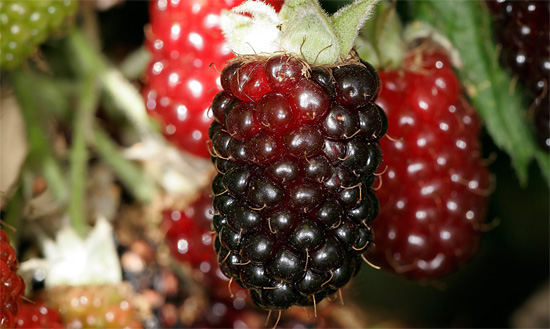
The Boysenberry variety is considered one of the best. It was bred in 1923 by Californian farmer Rudolph Boysen and is still used by farmers today. Currently, there are quite a few varieties and clones of the Boysenberry Ezemalina - therefore, it can only be called a variety with a certain stretch.
The hybrid was obtained by crossing the Loganberry, common raspberry and blackberry.
Description and reviews
Shoots are long, creeping. Leaves are light green.
The berries are large, up to 5 cm long, weighing up to 10 grams, dark cherry color. The berries that have reached full ripeness are almost black. The taste is excellent, sweet, blackberry aroma, strong. Fresh berries are used for the preparation of sweet dishes, desserts, as well as in the cosmetic industry. Thornless clones are widely used in industrial fruit growing, mainly in the United States. This variety is very promising for Russia, but so far Boysen's berry is grown mainly by amateur gardeners.
Texas
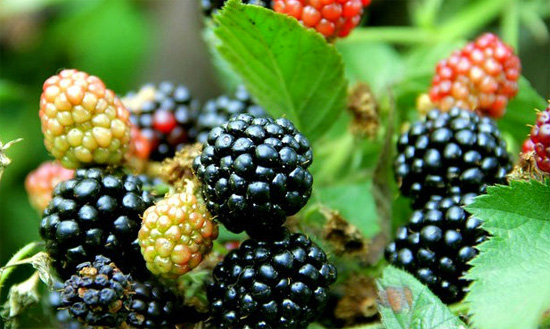
According to unverified data, the Texas variety was bred by Michurin on the basis of Loganberry.
Description
Shoots are long, creeping, up to 4 meters long. Annual shoots are green, with numerous thorns, biennial brown, partially lignified. The leaves are large, green above, whitish-green below, thorns on the midrib. Flowers are large, pedicel with thorns.
Berries of the Texas berry are large, red at the beginning of ripening, then dark cherry. Red berries are sweet and sour, dark - sweet with a slight sourness and with a blackberry aroma. The stalk does not separate from the berry.
The yield is high. With proper care, up to 6 kg of berries can be harvested from an adult five-year-old bush. Bushes remain productive for up to 15 years.
Ezhemalina Texas is well adapted to the climate of the Middle Lane, it tolerates even harsh winters and gives a good harvest even in cold, rainy summers. At the same time, not the best taste, the abundance of thorns that make harvesting difficult and the difficulty in separating the stalk make this variety unsuitable for commercial use.
Darrow
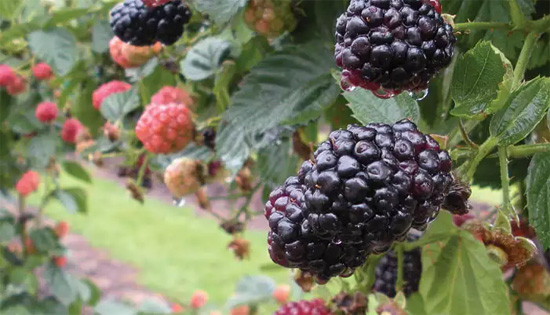
Ezhemalina Darrow varieties are easy to recognize by high (up to 3 meters) erect shoots. The shoots can bend under the weight of the leaves and the harvest, and therefore they need to be tied on a trellis. The berries are small, weighing up to 4 grams, purple-red. The taste is sweet and sour.
The variety is distinguished by high frost resistance and productivity - adult bushes are capable of producing up to 10 kg of berries. Otherwise, it is inferior to the Boysenberry variety.
Growing and caring
Ezhemalina is quite unpretentious: everyone can cope with caring for her and get a decent harvest. Therefore, if this culture is, in principle, interesting to you (well, who might not be interested in it?), Buy seedlings and start planting.
The soil
You can grow Yezemalina on any site, but fertile, loose, moderately moist soils are best suited. In general, plants tolerate drought better than waterlogging. It is good if the site is protected from the wind: despite the high winter hardiness, in frosty windy weather, the shoots can still be damaged.
Planting jemalina
It is better to plant ezhemalin in spring or autumn. If you have to plant vegetative seedlings, you should try not to damage the clod of earth.
It is recommended to plant bushes in rows with a distance between plants of 70 ... 100 cm and between rows of 150 ... 200 cm. With a denser planting, the bushes will not have enough sunlight, and the yield will be lower than possible.
Prepare planting pits 40x40x40 cm in size. Mix the soil extracted from the pit with humus, if you have one. If not, that's okay. You should not replace humus with manure or chicken droppings: increased doses of organic fertilizers cause increased growth, but reduce winter hardiness, and it is already not very high in the first winter after transplantation.
Place the seedling in the hole and spread its roots. Carefully fill the hole with prepared soil, compact the soil around the plant and water abundantly. Top up and compact the soil if necessary. If mulch material is available, cover the soil with it.
Caring for ezemalina
Caring for ezmalina includes:
- plant formation;
- tying on a trellis;
- loosening the soil and removing weeds;
- watering;
- top dressing;
- protection from plants and pests.
Plant formation and preparation for winter
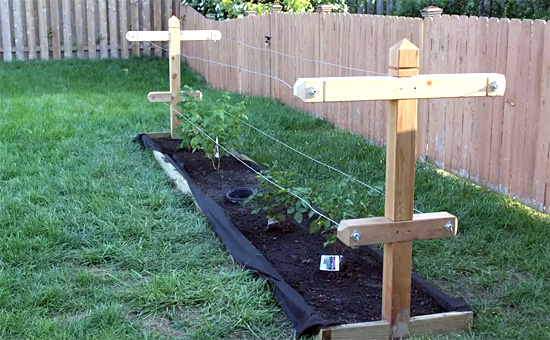
In shoots that have reached a length of 2 meters, pinch the tops. This provokes their branching. The longest side shoots can also be pinched.
In warm regions, the shoots with which the berries were collected are cut out, and the young replacement shoots are placed in the corners of a conditional square, in the center of which is the head of the bush.
In regions with cold winters, those that bear fruit are not cut out in autumn. They (like young shoots) are untied from the trellises, laid on the ground and covered. Leaves, straw, peat, burlap, etc. can be used as a covering material.
Tying on a trellis
The stalks of the yogurt cannot support their own weight and the weight of the crop, so they are tied to a trellis. There are usually two tapestries: one runs at a height of about a meter, the other at a height of 1.5 ... 2 meters. Young shoots are tied to the lower trellis, fruiting ones - to the upper one.
Tying not only makes it easier to care for and harvest the harvest: the shoots attached to the trellis are better illuminated by the sun, do not break or become dirty during rains. They are less affected by diseases.
Watering
Ezhemalina is drought-resistant. It should be watered as needed, and with regular, albeit infrequent rains, it is not necessary at all. During the formation and ripening of fruits, plants are more demanding on moisture.
Top dressing
The first feeding with organic fertilizers should be carried out two years after planting. There are no scientifically developed recommendations on the dosage of fertilization specifically for the raspberry, but you can be guided by the recommendations for ordinary raspberries. So, once every 2 ... 3 years, about 300 ... 500 kg of manure per 100 m2 and 1 kg of phosphorus and potassium fertilizers per 100 m2 in terms of the active ingredient should be applied under raspberries. This means that double superphosphate should be added about 2 kg, simple superphosphate - about 5 kg, potassium sulfate (potassium sulfate) - about 2 kg per 100 m2. Fertilizer doses should be adjusted depending on soil composition and nutrient removal.
Weed control
Ideally, the soil should be completely free of weeds, and a situation where plants are forced to break through perennial sod is completely unacceptable. Weeds, if there are many of them, take up most of the nutrients: in addition, they serve as food for many pests. With significant weediness, the yield of yogurt can be reduced by 5 ... 10 times. I will not write about the methods of weed control: everyone already knows how to do it.
Mulching
Mulching reduces weeds, increases soil temperature and reduces moisture loss. In addition, rotting mulch serves as an additional source of nutrients.
Straw, dry peat, straw manure, grass cuttings or rotted sawdust can be used as mulch for the raspberry.
Reproduction of ezemalina
Ezhemalina is propagated mainly vegetatively:
- green cuttings - you can simply remove the tops of the shoots of annual shoots - for this, in August, the top is cut off with a length of 20 ... 35 cm and planted in the soil to a depth of about 20 cm. The next year, each such cutting forms up to 4 full-fledged plants;
- lignified cuttings;
- root cuttings - in the spring, they dig up the roots, take in those that have reached a thickness of 5 ... 7 mm, cut into pieces about 15 cm long and immediately planted on ridges to a depth of about 20 cm.
Seed reproduction is not practiced, because subsequent generations do not inherit the parental properties.
Protection from pests and diseases
Diseases and pests of the raspberry are the same as those of the common raspberry, but the raspberry is susceptible to them to a much lesser extent. Plants are affected by powdery mildew, verticillum (verticillium wilting), raspberry rust and some other fungal diseases. However, not all - so, for example, the Yangberry and Boysenberry varieties are affected by verticillium and powdery mildew, but Loganberry is not. But Loganberry and Youngberry are affected by rust, and Boysenberry is resistant to it.
In general, recommendations for protecting ezemalina from diseases and pests for Russia have not yet been developed, but you can use the same agrotechnical and chemical methods that are used to protect raspberries. In the future, I plan to publish several translated materials on the protection of this culture. Don't switch!

